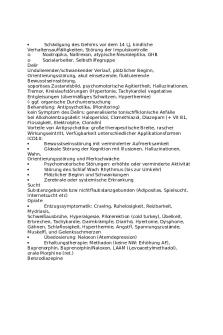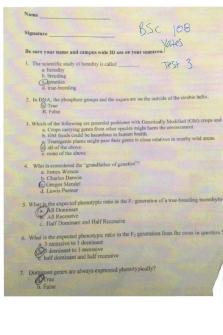Liebermann Nitroso Test and Ninhydrin Test PDF

| Title | Liebermann Nitroso Test and Ninhydrin Test |
|---|---|
| Author | Fatima Santos |
| Course | General Chemistry |
| Institution | University of the Philippines System |
| Pages | 4 |
| File Size | 418.4 KB |
| File Type | |
| Total Downloads | 95 |
| Total Views | 125 |
Summary
Download Liebermann Nitroso Test and Ninhydrin Test PDF
Description
CLASSSIFICATION CLASSSIFICATION TEST CLASS CLASS TESTED TESTED FOR FOR PRINCIPLE PRINCIPLE
Liebermann Nitroso
Test for Phenols Confirmatory Test for Secondary Amines Phenols Phenols having having aa free free para-position para-positionundergo undergothis this reaction. reaction.
Both Both aliphatic aliphatic and and aromatic aromatic amines amines react react with with nitrous nitrous acid acid (HNO (HNO N-nitroso derivatives derivatives which which are liquids, in soluble in the reaction reaction
Therefore, Therefore, when when aa secondary secondary amine amine reacts reacts with with nitrous nitrous acid, acid, an an oo nitrosamine nitrosamine separates separates from from the the reaction reaction mixture mixture The The N-nitrosamine N-nitrosamine obtained obtained by by the the reaction reaction of of aa secondary secondary amine amine HNO 2 isheated heatedwith withphenol phenolin inthe thepresence presenceof ofconcentrated concentratedsulfur sulfu
MATERIALS MATERIALS
The Theformed formedp-nitrosophenol p-nitrosophenolundergoes undergoesfurther furtherreaction. reaction.[see [seefirst first GLASSWARES GLASSWARES REAGENTS REAGENTS Beakers (50-ml) 5% Sodium nitrite (NaNO 2) Test tubes Conc. Sulfuric acid (H 2SO4) Test tube holder 5% Sodium hydroxide (NaOH) Alcohol lamp Hydrochloric acid Droppers 5% Sodium nitrite (NaNO 2) Spatula Sodium nitrite (NaNO 2 )
SAMPLE PREPARATION PROCEDURE
POSITIVE TEST
COMPLICATIONS
CLEANING UP REFERENCES
EDITED BY
The organic compound to be tested should be pure. Purification s necessary for compounds with impurities. Take the compound (100 mg) in a dry test tube, add sodium nitri (few crystals) and concentrated sulfuric acid (H 2SO4) (1 ml), m heat gently. A blue color is obtained. The solution turns red on d water (H2O) and blue on basification with a dilute solution hydroxide (NaOH). Treat the solution of secondary amine with HCl with sodium nitr (NaNO 2). Extract the N-nitrosamine with ether. Wash the ether e dilute urea solution to remove HNO 2. Then dry it over anhydrou Filter and evaporate ether (caution, ether is highly flammable). H residue with phenol (few crystals), cool, add concentrated H 2SO details of subsequent treatment see “Test for Phenols”above) It gives green to blue solutions which turned to red or violet, yel brown, respectively, after dilution with water. Alkalization of th solutions changed the color to green or blue, but also to yellow o respectively. Except for 4-iodophenol and hydroquinone, phenols substitu ted position will not react with either nitrite or p-nitrosophenol. Neg reactions will be obtained with 2- and 3-nitrophenols, 2- and 3 hydroxybenzoic acids and 2,6-dichlorophenol, although these ph a free p-position. The sensitivity is much poorer than that of othe for detection of phenols, e.g. the Emerson or Gibbs reactions. Th Liebermann test is often recommended as a generic test for phen importance, selectivity and sensitivity seem to have been conside overestimated. Application of the reaction for spectrophotometric determination of phenols is impracticable, because of the very po reproducibility, the small yield of reaction product and the inconv working with concentrated sulfuric acid media. (Fraenkl et al, 19 The obtained mixture of reagents after the test should be stored in bottle properly labell ed and be subjected for treatment. Ahluwalia, V.K., & Dhingra, S. (2004) Comprehensive Practica Chemistry: Qualitative Analysis . Telangana, India: Universities Fraenkl, M., Svobodová, D., & Gasparič , J. (1986) A critical inv of the liebermann colour test: The formation and behaviour of phenolindophenol in strong acid media.Microchimica Acta,90( 386. Diana V. Montecastro BS Chemistry 4
CLASSSIFICATION TEST Test for Amino Acids CLASS TESTED FOR PRINCIPLE In the pH range of 4-8, all α - amino acids react with ninhydrin (triketohydrindene hydrate), a powerful oxidizing agent to give a colored product (diketohydrin) termed Rhuemann’s purple. All p amines and ammonia react similarly but without the liberation of dioxide. The imino acids proline and hydroxyproline also react w ninhydrin, but they give a yellow colored complex instead of a pu Besides amino acids, other complex structures such as peptides, p and proteins also react positively when subjected to the ninhydrin reaction.
Ninhydrin
MATERIALS
SAMPLE PREPARATION PROCEDURE POSITIVE TEST
GLASSWARES REAGENT Beakers (50-ml) Ninhydrin (2%W/V) in Test tubes Test tube holder Alcohol lamp Droppers Spatula Aspirator Pipet Stirrer Volumetric flask Dissolve 20 mg of the compound in 1 ml water or appropriate so Heat a small amount of the aqueous solution of the organic comp mg in 1 ml water) with a ninhydrin solution (1 ml) for 15-20 sec The appearance of a blue-violet color indicates t he presence of a amino acid.
REFERENCES
Ahluwalia, V.K., & Dhingra, S. (2004) Comprehensive Practica Chemistry: Qualitative Analysis . Telangana, India: Universities vlab.amrita.edu, (2011). Qualitative Analysis of Amino Acid. Re January 2018, from vlab.amrita.edu/?sub=3&brch=63&sim=109
EDITED BY
http://kimiagar2010.blogspot.com, (2010). Detachment and Iden Organic Compound. Retrieved 13 January 2018, from kimiagar2010.blogspot.com/2010/05/procedure-add-about-2-mg to-1.html Diana V. Montecastro BS Chemistry 4...
Similar Free PDFs

Test - test
- 1 Pages

Test Out 1 Test and Quizzes
- 7 Pages

Test, questions and answers
- 8 Pages

Test, questions and answers
- 7 Pages

Test, questions and answers
- 21 Pages

Test, questions and answers
- 43 Pages

Happiness and Stress Test
- 2 Pages

Test questions and answers
- 10 Pages

Generate-and-Test (GT
- 10 Pages

Test, questions and answers
- 13 Pages

Test, questions and answers
- 48 Pages

Test, questions and answers
- 14 Pages

Yates Test 3 - Test
- 7 Pages
Popular Institutions
- Tinajero National High School - Annex
- Politeknik Caltex Riau
- Yokohama City University
- SGT University
- University of Al-Qadisiyah
- Divine Word College of Vigan
- Techniek College Rotterdam
- Universidade de Santiago
- Universiti Teknologi MARA Cawangan Johor Kampus Pasir Gudang
- Poltekkes Kemenkes Yogyakarta
- Baguio City National High School
- Colegio san marcos
- preparatoria uno
- Centro de Bachillerato Tecnológico Industrial y de Servicios No. 107
- Dalian Maritime University
- Quang Trung Secondary School
- Colegio Tecnológico en Informática
- Corporación Regional de Educación Superior
- Grupo CEDVA
- Dar Al Uloom University
- Centro de Estudios Preuniversitarios de la Universidad Nacional de Ingeniería
- 上智大学
- Aakash International School, Nuna Majara
- San Felipe Neri Catholic School
- Kang Chiao International School - New Taipei City
- Misamis Occidental National High School
- Institución Educativa Escuela Normal Juan Ladrilleros
- Kolehiyo ng Pantukan
- Batanes State College
- Instituto Continental
- Sekolah Menengah Kejuruan Kesehatan Kaltara (Tarakan)
- Colegio de La Inmaculada Concepcion - Cebu


